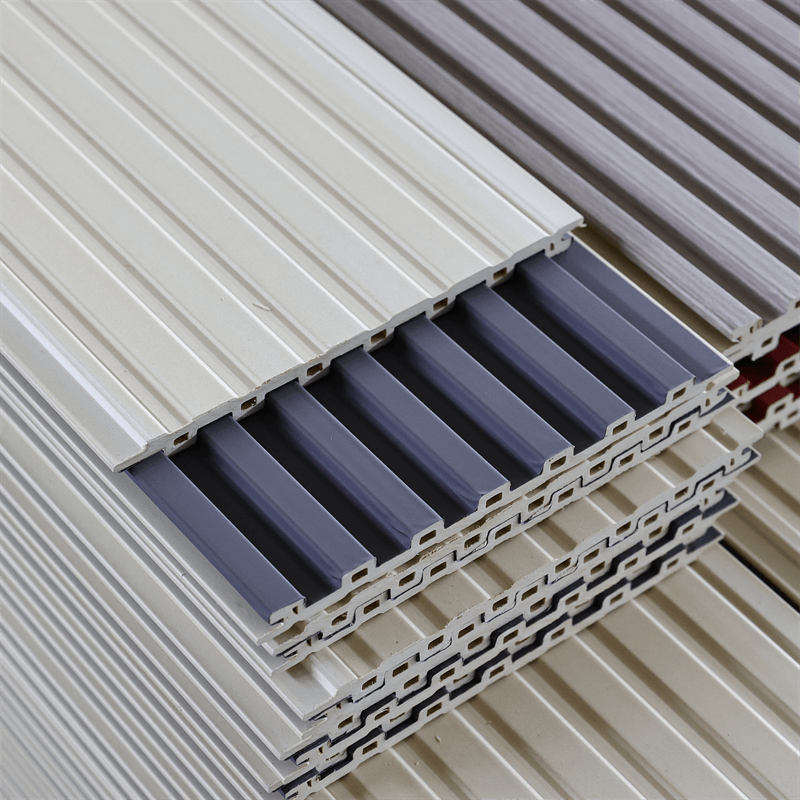
When it comes to choosing materials for interior and exterior design projects, architects and designers are faced with a multitude of options.
One of the innovative choices gaining popularity is Wood-Plastic Composite (WPC) fluted panels.
These panels offer a blend of natural aesthetics, durability, and sustainability.
However, traditional materials such as wood, plywood, and plastic also remain widely used.
In this article, we will compare WPC fluted panels to traditional materials to help you make an informed decision and choose the right material for your project.
WPC Fluted Panels: The Introduction
WPC fluted panels are composite materials made by combining wood fibers or flour with thermoplastics like polyethylene, polypropylene, or PVC.
The resulting mixture is heated and compressed to create panels with a fluted design on the surface, adding texture and enhancing structural integrity.
These panels have gained popularity for their natural wood-like appearance, durability, and sustainable attributes.
Natural Aesthetics: WPC fluted panels provide the warm and inviting aesthetics of natural wood, making them suitable for both interior and exterior design projects.
The fluted design on the panels adds depth and character to spaces.
Durability: The combination of wood fibers and thermoplastics enhances the panels’ durability, allowing them to withstand various environmental factors such as moisture, UV rays, and temperature fluctuations.
Sustainability: WPC fluted panels utilize recycled materials and reduce the demand for virgin wood, contributing to sustainable construction practices and reducing environmental impact.
Low Maintenance: WPC fluted panels require minimal maintenance, reducing long-term upkeep costs compared to traditional materials like wood that may require frequent painting or sealing.

Wood: The Timeless Classic
Wood has been a staple in construction and design for centuries, offering a timeless and natural appeal.
It is available in various species and finishes, providing a wide range of design possibilities.
Natural Beauty: Wood’s natural grain and texture add a unique charm to any space, creating a warm and welcoming ambiance.
Versatility: Wood can be used for a wide range of applications, from flooring and wall paneling to furniture and cabinetry.
Renewable Resource: When sourced responsibly, wood can be a renewable and eco-friendly material.
Repairability: Damaged wood can often be repaired or refinished to restore its original appearance.
Plywood is a sheet material made by gluing several layers of wood veneers together. It offers strength, stability, and a smooth surface.
Strength and Stability: Plywood’s layered construction provides strength and resistance to warping or shrinking, making it suitable for structural applications.
Cost-Effective: Plywood is generally more affordable than solid wood, making it a budget-friendly option for various projects.
Wide Availability: Plywood is readily available in different thicknesses and grades, making it easy to find the right fit for the project.
Versatile Applications: Plywood can be used for various interior and exterior applications, from furniture and cabinets to walls and roofing.
Plastic: The Practical Material
Plastic materials, such as PVC and HDPE, have gained popularity in construction due to their versatility and low cost.
They are used in various forms, including vinyl siding, PVC panels, and synthetic lumber.
Water and Moisture Resistance: Plastic materials are highly resistant to water and moisture, making them suitable for wet and humid environments.
Low Maintenance: Plastic materials require minimal maintenance and are easy to clean and maintain.
Longevity: Plastic materials have a long lifespan and do not rot, decay, or corrode like some traditional materials.
Affordability: Plastic materials are often more cost-effective compared to natural materials like wood.

Comparing WPC Fluted Panels to Traditional Materials
WPC fluted panels offer the aesthetics of natural wood, providing a warm and inviting ambiance similar to traditional wood.
However, wood remains the classic choice for its unique grain patterns and natural charm.
Plywood and plastic may lack the same level of natural appeal as WPC fluted panels or wood.
WPC fluted panels and plywood offer good durability and resistance to environmental factors.
While wood can be durable, its longevity depends on the specific wood species and how well it is maintained.
Plastic materials, on the other hand, excel in water and moisture resistance but may not match the strength and structural stability of WPC fluted panels and plywood.
WPC fluted panels stand out for their sustainable composition, utilizing recycled materials and reducing the demand for virgin wood.
Wood, when sourced responsibly, can be a renewable resource.
However, certain wood species may have environmental concerns if not responsibly managed.
Plywood is a resource-efficient material, as it maximizes the use of wood through its layered construction.
Plastic materials, although durable and low-maintenance, may pose environmental challenges related to their production and disposal.
WPC fluted panels, plywood, and plastic materials generally require minimal maintenance,
reducing long-term costs compared to traditional wood that may need regular sealing or staining.
However, wood’s repairability can be an advantage, as damaged areas can be refinished or repaired without replacing the entire material.
Choosing the right material for your design project is a critical decision that impacts aesthetics, performance, and sustainability.
WPC fluted panels offer a unique blend of natural aesthetics, durability, and sustainability, making them an innovative choice for modern construction.
While traditional materials like wood, plywood, and plastic each have their advantages, WPC fluted panels stand out as a versatile and eco-friendly option.
Consider the specific requirements of your project, such as the desired aesthetics, environmental impact, and long-term maintenance needs,
to make an informed decision and choose the material that best suits your design vision and project goals.
